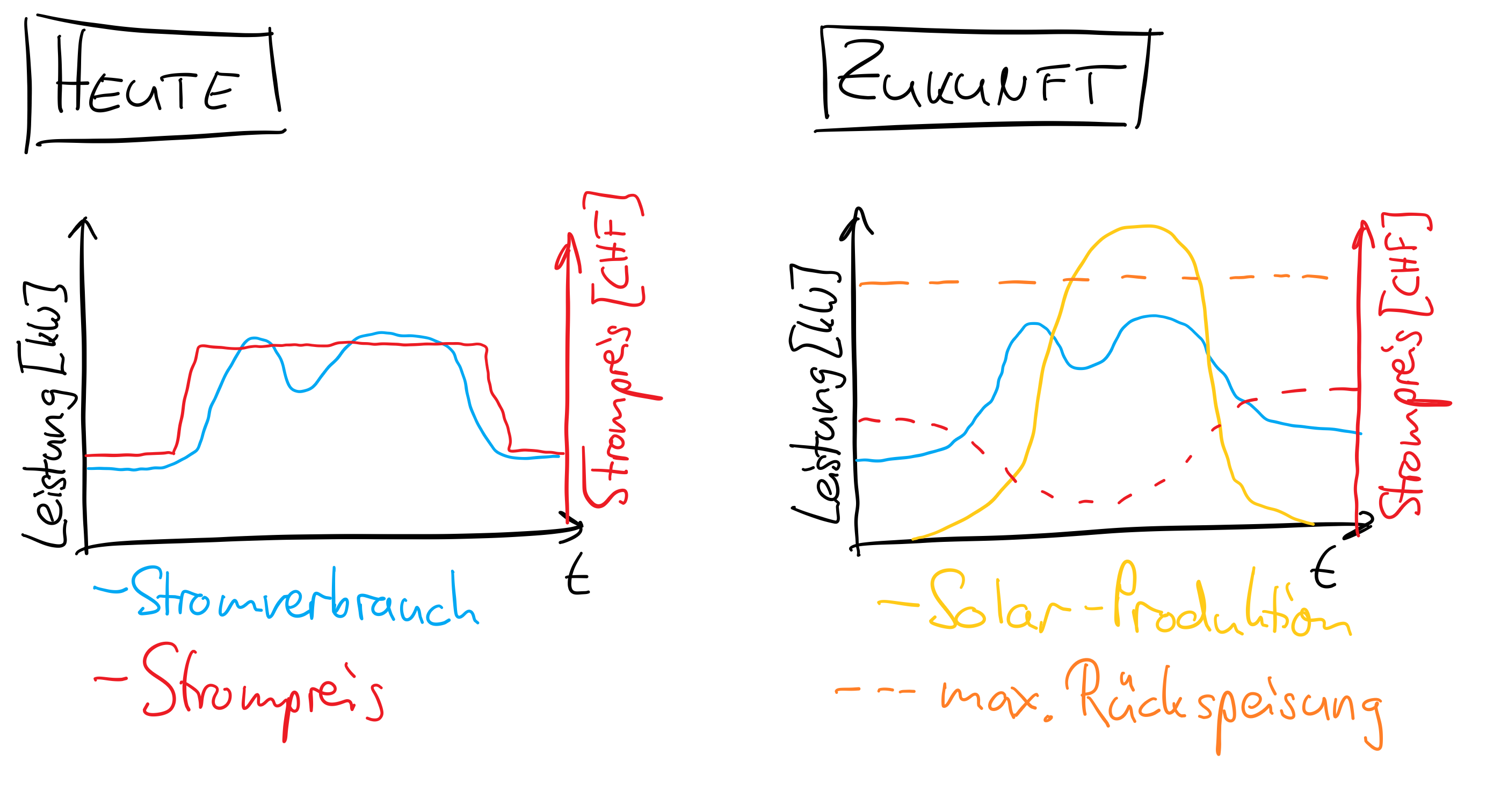Report
💡 Active projects and challenges as of 04.12.2025 17:58.
Hide text CSV Data Package Print
Algorithmische Erneuerungsplanung
Value consequences in maintenance infrastructure for power supply
Challenge
Objectives Wert von der Standhaltung und die Folgen von Infrastrukturhaltung. Topogie und Geometrie von der Betriebsnetz rekonstruieren.
Process Based on existing Geodata a graph-based model was made. The optimisation algorithm was applied to find an optimal path.
Data
Challenge_Unterhalt_Ausbau Shape data format .shp Excel data over energy consumption per dwelling or commercial property
Tools
This team analysed the value and importance of infrastructure maintenance work, using following tools → QGIS, rhino, grasshopper, mapbox, jupyter notebook (used libraries are to be updated).
The Slack channel #energy-plan is used for communication.
Results
Optimisation Algorithm was applied over a graph for finding the required maintenance root.
Formed a working version on the GitHub
Team
Members are @wolfram and @dimi
Energie-Erneuerungsplanung
Topic: Algorithmic solution for valuing consequences in infrastructure maintenance
This project reflects this challenge
Challenge
Maintenance of company assets of the low-voltage power distribution grid should be prioritized based on asset state and asset importance. While the state of the asset, typically the age since the last maintenance, is well-document, there is currently no measure of importance for these assets. One idea to value the importance of the assets is to analyze the amount of energy that is distributed by them. The amount of consumption is, of course, not an optimal measure for how damage is caused by an asset breakdown, or for what consumer would pay for an insurance against power interupts - if they were allowed to pay for it. This challenge, therefore, leave it open how, for the purpose of optimization, the importance will be measured.
Provided Data
The data that was provided consisted of
- List and point coordinates of transformer stations
- List and point coordinates of distribution enclosures
- List and point coordinates of consumers
- List and line coordinates of connection lines
- Anonymized consumption data for the last four years
Approach
Since no importance measure was given, but consumption can be considered a first good proxy and consumption is only known per consumer but not per connection line, distribution enclosure or transformer station, the first part of the project was dedicated to enriching the data by calculating these figures.
The second part of the project focussed on the optimization of the prioritization of maintenance work based on a flexible importance measure.
Data enrichment
The basic idea is to calculate the amount of energy that flows through transformer stations, distribution enclosures and connection lines by analyzing the topology of the network, starting from the transformer stations. This topology is constructed from the point and line coordinates. The quality of the coordinates is high enough to do this correctly.

After the topology of the network and the distrance from the transformer stations is created, the yearly power consumption is aggregated for each element of this network starting with the ones that are the furthest away from the transformer stations. The maximum depth of the network is 17 hops.
The data is visualized in an open source software QGIS. This calculated data is added to the network elements such that the visualization can be enhanced by this data. The size of the points and the width of the lines now corresponds to the amount of energy that flows through this element.
This is a larger view of the results.
(brown - transformer station, red - distribution enclosure, orange - consumer, red - connection line)

This is a more detailled view of the results.

Optimization
References
Blackout Karte
Identify causes of blackouts in networks
openData_eniwa
Wir haben uns bei der Erstellung der Blackoutkarte vorerst auf das Medium Elektro beschränkt, wobei der Ansatz grundsätzlich auf andere Medien übertragen werden kann und auch für andere Grundlagedaten angewendet werden kann. Herausforderung war und wird sein passende Grundlagedaten für die Analysen zu finden. Als Tool wurde vorwiegend QGIS verwendet
Als erstes haben wir verschiedene Gefahren definiert.

Als nächstens haben wir die unterschiedlichen Karten vereinheitlicht und normert, damit sie im nächsten Schritt miteinander verrechnet werden können. So wurden die unterschiedlichen Farben in hohes Risiken mit dem Wert 200, mittleres Risiko 100 und geringes Risiko 50 konvertiert. Die normierten Risiken wurden nun zusammen addiert. Die Risiken können beim addieren noch unterschiedlich gewichtet werden. In unserem Beispiel haben wir die beiden verwendeten Risiken gleich gewichtet.

Die bestehenden Leitungen inkl. Einteilung der Wichtigkeit der Leitungen lag als CSV vor und wurde mittels SpatialLite in QGIS hinzugefügt. Die gewichtete Risikokarte wurde mit den Leitungen multipliziert, wodurch die neuralgischen Punkte aufgrund Risikowahrscheinlichkeit und Relevanz der Anlagen/Leitugen ermittelt werden konnten.

Die gewichtete Risikokarte wurde weiter in QGIS als 3D-Map visualisiert und mit den Leitungen überlagert.
Das Risiko bestimmt die Höhe des Geländes, das heisst je höher ein Punkt, umso wahrscheinlicher ein Vorfall.

Die Berechnungen wurden in Python umgesetzt und als QGIS Analysen
Freestyle
Gamify your Electricity Usage
Freestyle is an app that helps people use energy in time periods that are less burdened.
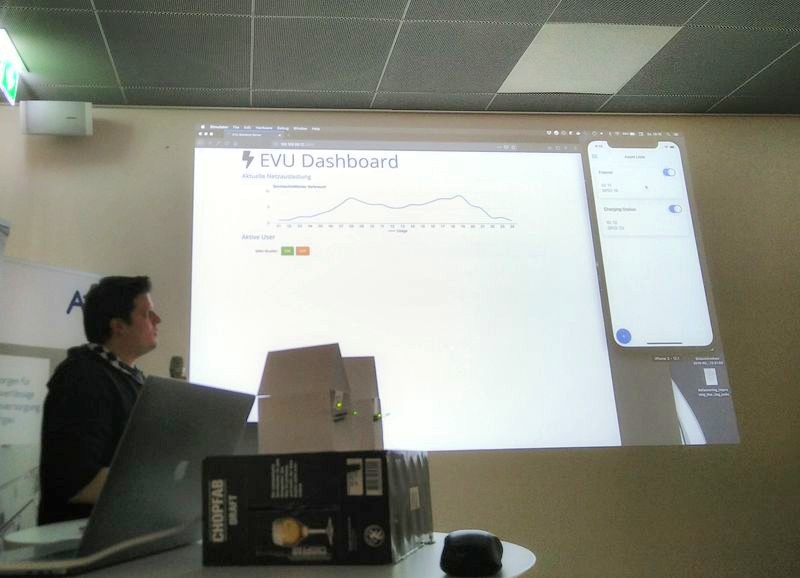
Wir sind nur zu 3. Wir möchten einen App machen zum Zeitperiode lenken die auf der Kurve nicht so belastet sind. Wir haben verschiedene Geräte die nicht der ganzen Tag laufen müssen. Unseren Tool soll erlauben EV einzugeben und plannen, und die Kurve abzugleichen. Gamification kommt darein. Wir sind daran die Infrastruktur aufzubauen, den App zu schreiben, schauen was passiert.
Challenge
Code
- https://github.com/lichtwellenreiter/eh_app
- https://github.com/lichtwellenreiter/eh_evu
- https://github.com/lichtwellenreiter/eh_haushalt

Gebäudepass "Cloud"
Solutions for a Building Passport
Gebäudepass is developing a "building passport" that documents and portrays all relevant energy-related information about a building. The goal is to develop a concept that helps the state, canton, municipalities and / or cities to evaluate their state and needs when it comes to buildings.
Challenge: Gebäude-pass Demo: abdagon.wwwnl1-ls3
Challenge Ergebnisse
Die Ergebnisse sind in einer Präsentation und deren Anhang dokumentiert, inkl. Visualisierungen (siehe oben)
Research
- In Europa bestehen viele Studien und Projekte für Gebäudepässe (Präsentation Anhang)
- Für Gebäudesanierungen existiert eine ausgereifte Lösung eValo
- Viele Daten existieren, sind aber nicht zugänglich
Potentiell verfügbare Daten für Gebäudepass "Cloud"
- GWR (Gebäude- und Wohnungsregister)
- EVU CRM, Leitung-Kataster, ...
- Sonnendach
- Erdwärme
- Feuerungs Datenbank
- Pro Novo (SwissGrid Photovoltaik)
- Evtl. dynamische Messdaten (Strom, Heizungsrechnung)
Datenhack Raumwärme Aarau
GWR enthält potentiell viele Daten, darf jedoch nicht in vollem Umfang genutzt werden - der Datenhack war auf Raumwärme und Warmwasser Aarau beschränkt
Gebäudepass «Cloud» - Zielsetzung
- Nutzung existierender Daten – Vermeidung von Mehrfach-Erfassungen
- Plattform für Energie- und Investitions-Optimierung für Gebäudebesitzer, Gemeinden, Kantone, Bund, Energieversorger
- Nutzung ergänzender Daten für plausible, konkrete und frühzeitige Optimierungs-Vorschläge (z.B. Verfügbarkeit Gas, Fernwärme, ...)
- Prozesse (inkl. Validierung) und Anreize (z.B. Steuererleichterungen) für hohe Datenqualität
Gebäudepass «Cloud» - Nutzen
Gebäudebesitzer
- Vorschläge für Sanierungsmassnahmen
- Business Cases für Energie Optimierungen
- “Preventive Maintenance”
- “Logbuch” für Sanierungen
- Dokumentation für Verkauf
Gemeinden, Kantone, Bund, Energieversorger
- Verbesserung Datenqualität mit Bevölkerung
- Energieplanung
- Umsetzung Strategie 2050
- Validierung Förderungsystem
- Quantifizierung
- Simulation, Szenarien
Gebäudepass «Cloud» - Prototyp
Auf der CMS Drupal Plattform wurde mit einem Aufwand von ca. 1 Stunde ein einfacher Prototyp für einen webbasierten Prototyp entwickelt, um die mögliche Funktionalität zu demonstrieren. Eine solche Anwendung hat ohne Daten jedoch nur einen geringen Nutzen.
http://abdagon.wwwnl1-ls3.a2hosted.com/bp/web/
Gebäudepass «Cloud» - Erkenntnisse
- Einzellösungen vorhanden
- Fehlende Integration – Mehrfacherfassungen nötig 🤮
- Teilweise ungenügende Datenqualität – fehlerhafte bzw. veraltete Daten
- Sehr viele Daten existierend – aber in Silos und nicht zugänglich
- Nutzung möglichst vieler bestehender Daten – mit kontrolliertem Zugang
- Datenzugang mit Identifikation ermöglichen, Nutzung protokollieren
Gebäudepass «Cloud» - Projekt
- Fokus Gemeinde – PoC Aarau, mit Zukunftsregion Argovia
- Daten von GWR, EVU – eValo Anbindung
- Zugang mit Identifikation (SwissID)
- «Abfragen» für Nutzen Optionen
Erstes update
Wir haben uns überlegt wie eine Gebäudepass aussehen könnten, verschiedene Daten angeschaut. Es gibt in andere Ländern bereits Lösungen für den Gebäudepass - wir fokussieren uns um die Frage, wie wir an die Daten herankommt. 2 Problemfelder: die Daten sind z.T. nicht öffentlich zugänglich, auch wenn durch Steuer bezahlt. Was man zusammenkriegt genügt nicht zum zusammenzuladen. Wir haben den Gebäudepass gedacht für Gebäudebesitzer. Eine schöne Grafik wäre interessant auch für Bund, Kantone, Gemeinde zum gemeinsame Bilder von Bedarf zu setzen. Wir sind am abklären ein Projekt zu machen mit der Zukunftsregion Aargau. Wir haben uns gefragt wer und wo interessiert wäre mitzumachen. Stadt Aargau prüft schon ob sie könnten eine Proof of Concept machen. Wir überlegen uns wie das Projekt aussieht, und ganz schnell zu Prototypen kommen.
Jambricks
Plug n' play on your hackathon way!
This project devises a fun way to investigate the equipment that people bring to a hackathon, and provoke conversation about energy usage and standards.
How to
1. Bring a kitchen scale to the hackathon, or find one on location

(Thanks, Bernhard!)
((The Micro:bit is just for decoration - bonus points for using a smart scale!))
2. Collect the data in some way. You can use our proto-app, for instance.
--> JamBricks App <--
NB: the data is not yet saved anywhere except on your own computer!
3. Measure the Weight (in grams) of every participant's power supply and read the Wattage from the label.
Pro tip: if the Wattage is not stated, multiply the number of Volts by the Amps, e.g.:
19.5V x 3.34A ~= 65W
4. Copy and paste the resulting totals on your project page, and ask the other teams to do the same!
For example, you would get something like this:

Show me the data
You can find a table of all of our results from #energyhack19 here (GitHub)
We dragged a total of 12.0 kg of power supplies rated a total of 3'890 W across all 59 people surveyed. Some people did not have a PSU and seemed to last the hackathon on a battery charge - what's your secret?
Congratulations to Andreas for bringing the "heavy" to the Hackdays, a 435 g brick, which also is the highest rated we found at 148 W.
Wait, but why?
Laptops and other mobile computing devices are a prerequisite of hackathons. You could support your team's design efforts with a pad of paper and pencil, and you should - but most people would feel left out if they came to a coding party without their devices.
People bring all kinds of hardware to hackathons. Back in the days of the LAN party we used to bring whole PCs and bulky monitors on site. These days we might do well to do our coding for the weekend on an tablet. In sports, people pay attention to the "hardware": the shape and size of bicycles or skis, for instance.
We have never thought about the power consumption figures of our computers before - but today the issues of the excessive energy consumption of IT projects is a topic of public concern (WIRED). Some people complain about their heavy power supplies, and we started wondering why Smart Homes and Offices don't have DC plugs, and got into a bit of the history of (the lack of) electricity standards.
With this project we aim to provoke some conversation about an overlooked element that may contribute to successful collaboration.
Inspirational quote
It would be quite possible to devise a universal DC outlet that depended on an ID signal from the device being supplied, either from its cable or the from the device. This only needs to be a unique ID. As we only need a small range of voltages, typically from 3V to 24V we wouldn’t need a complex code. An intelligent adaptor in the outlet would then set the voltage needed by that device. In a way this is done already with the plug and socket combination identifying the voltage. This also shows up the weakness of a smart outlet. You only need a lightweight connector for a device drawing small currents (e.g. Micro-C USB), but something more substantial would be needed for devices like printers and monitors that might draw peak currents of two or three amps. Perhaps two different sockets, one for low, and one for high power would be acceptable.
-- Rob Gillatt, Electronics Engineer via Quora
Credits
The web application is made with Vue.js based on the TodoMVC boilerplate. You can fork the source code at JSFiddle.
Inspired by crowdsourcing data from participants, by physical hackathon projects like Aufschnitthilfe, and by midnight reading about the reasons we cannot plug our devices directly into wall sockets.
🧱 3 bricks | 155 W | 261 g
Ladestationen-Standortplanung
A view on the future of planning
Projektziel
Planungshilfe für neue Standorte von E-Mobil-Ladestationen, die öffentlich zugänglich sind.
Analyse der Ausgangslage und Formulierung der Fragestellung
Die unterschiedlichen Stakeholder (Verteilnetzbetreiber, Gemeinde, Nutzer eine Elektromobils) wurden analysiert und deren Anforderungen an Standorte für Ladestationen formuliert. Anschliessend wurden die Nutzungsformen (Private Nutzung für Einkaufen, Besuche / Arbeitsnutzung zum Pendeln oder Kundenbesuche / Freizeitnutzung für Ausflüge oder Reisen) der unterschiedlichen Nutzer (Familien, Einzelpersonen, Paare, ältere Personen...) unterschiedlicher Wohnformen (Einfamilienhaus, Mehrfamilienhaus, Eigentum oder Miete, städtisch oder ländlich) mit unterschiedlichen Mobilitätsformen (Privatauto, Miet- oder Sharing-Auto, Velo, Zug oder Tram/Bus) analysiert. Dazu könnte eine detaillierte Informationendatenbank aufbereitet werden.
Prototyp
Nach der Betrachtung vorhandener Daten und möglicher Umsetzungen aus Sicht der unterschiedlichen Stakeholder wurde für dieses Projekt beschlossen, dass ein Prototyp einer GIS-basierten Planungshilfe für Gemeinden erstellt wird. Mit der bestehenden Datengrundlage für den Kanton Aargau wie öffentlich zugängliche Ladestationen, Park&Ride Standorte, Park&Pool Standorte und Parkplätze des Tiefbauamts kann die Karte analysiert und Indizien für zusätzliche Ladestandorte eruiert werden.
Weitere Bearbeitung des Prototyps
Was zusätzlich eingebunden werden könnte: visualisierte Pendlerströme, Hauptverkehrsachsen (als Heatmap), SBB-Bahnhöfe, Standort von Trafostationen, Standort von PV-Anlagen, Standort von Batterien, bestehende (konventionelle) Tankstellen, Auslastung (Anzahl und Dauer der Parkplatznutzung, Anzahl und Dauer der Ladevorgänge) der Ladesäulen...
Teamwork
Unserer Team ist Freitag leider von 6 auf 3 geschrumpft. Ein Grossteil der Zeit wurde verwendet, die Fragestellung zu diskutieren, den UseCase einzugrenzen und vorhandene Daten zu finden. Am Samstag haben wir den Prototypen umgesetzt und das Projekt dokumentiert.
Challenge
Data
- https://lemnet.org/
- https://data.geo.admin.ch/ch.bfe.ladestellen-elektromobilitaet/data/ch.bfe.ladestellen-elektromobilitaet.json
- https://www.bfs.admin.ch/bfs/de/home/statistiken/mobilitaet-verkehr/personenverkehr.html
- Netzbetreiber Aargau
- Park & Ride Aargau
- Park & Pool Aargau
- Parkplätze Tiefbauamt Kanton Aargau
🚧 Under Construction 🚧
Load Profile Shaping
Lastgangskurven optimieren
Challenge (siehe Gamification Lastgang)
- Die heutigen Stromtarife (Hoch- & Niedertarif) entsprechen nicht mehr den auf dem Strommarkt gehandelten Preisen
- Die Lastgangkurven auf Bezügerseite werden mit der Verfügbarkeit von PV, Batteriespeichern und SmartHome Installationen nach und nach verändert.
- Durch den Mismatch der Preisanreize für Endkunden und EVUs können für EVUs erhebliche Gewinneinbussen entstehen.
- Über Mittag wird der Strompreis im internationelen Handel aufgrund der Produktion der Photovoltaikanlagen stark sinken
- Unsere APP soll den EVUs aufzeigen, wie diese Einbussen durch Anpassung der Anreize vermieden werden können
Lösungsansatz
Unsere APP zeigt dem EVU auf, wie es den Lastgang seiner Stromkunden zu seinen Gunsten verbessern kann. Anhand realer Referenz-Lastgänge und Strompreisen wird das neue Strommarkt-Design analysiert sowie untersucht, welche Parameter eine Anpassung des Lastgangs bewirken. Basierend auf diesen Erkenntnissen wird gemeinsam mit dem EVU eine neue Strategie entwickelt, welche die langfristige Zukunft der EVU sicherstellt. Dank der Optimierung der Strompreise gegenüber dem Endkunden, beispielweise mit dynamischen Strompreise, kann das EVU aktiv die Umgestaltung bewältigen und gleichzeitig die Energiewende voranbringen.
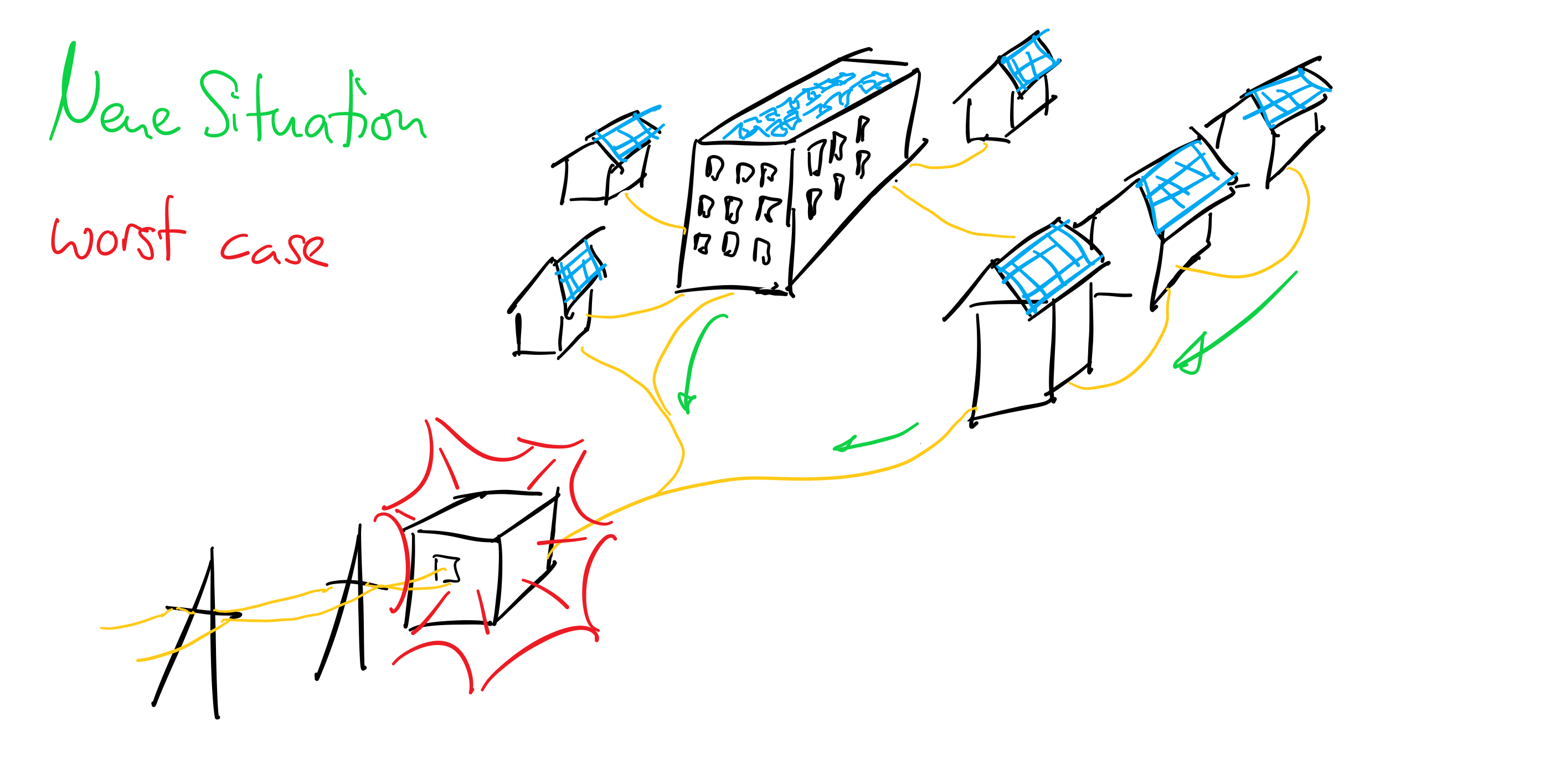
Mit unserem umfassenden Branchenkenntnis unterstützen unsere Projektleiter und Developer die EVU's dabei, wie auch im Zeitalter des erneuerbaren Strommarktes die Unternehmenszukunft mit aktiver Mitgestaltung und neuen Geschäftsmodellen gesichert ist.
Team
Unser Team besteht aus 2 Energie-Consultants, einem langjährigen Energie-Dienstleister und drei Web-APP Entwicklern:
- Thomas Strösslin, APP Unternehmensberatung AG
- Pascal Städeli, Linkedin
- Marco Pertegato
- Julian Schmuckli
- Nils Egger
- Leon Wink
Vorgehen
- Als Referenz-Lastgangkurve werden Daten aus dem Projekt VEiN aufbereitet
- Die Strompreise aus EPEX Spot werden gemittelt und normiert, um die stündlichen Preise eines Referenztages zu erhalten
- Als Preissignal wird ein gewichtetes Mittel zwischen EPEX Spot Preis und Hoch- & Niedertarif berechnet.
- Die Fähigkeit des Kunden, seinen Lastgang zu optimieren, wird anhand von 2 Parametern (Flexibilität Verbraucher sowie installierte Batterie) modelliert.
- Der Lastgang wird mit Hilfe des normierten Preissignals optimiert
Daten
- Strompreise an der intraday Strombörse EPEX Spot
- Lastgangkurven aus VEiN
- PV Produktionskurve aus eigenem Modell (Standort Zürich, PVSyst)
Business Case
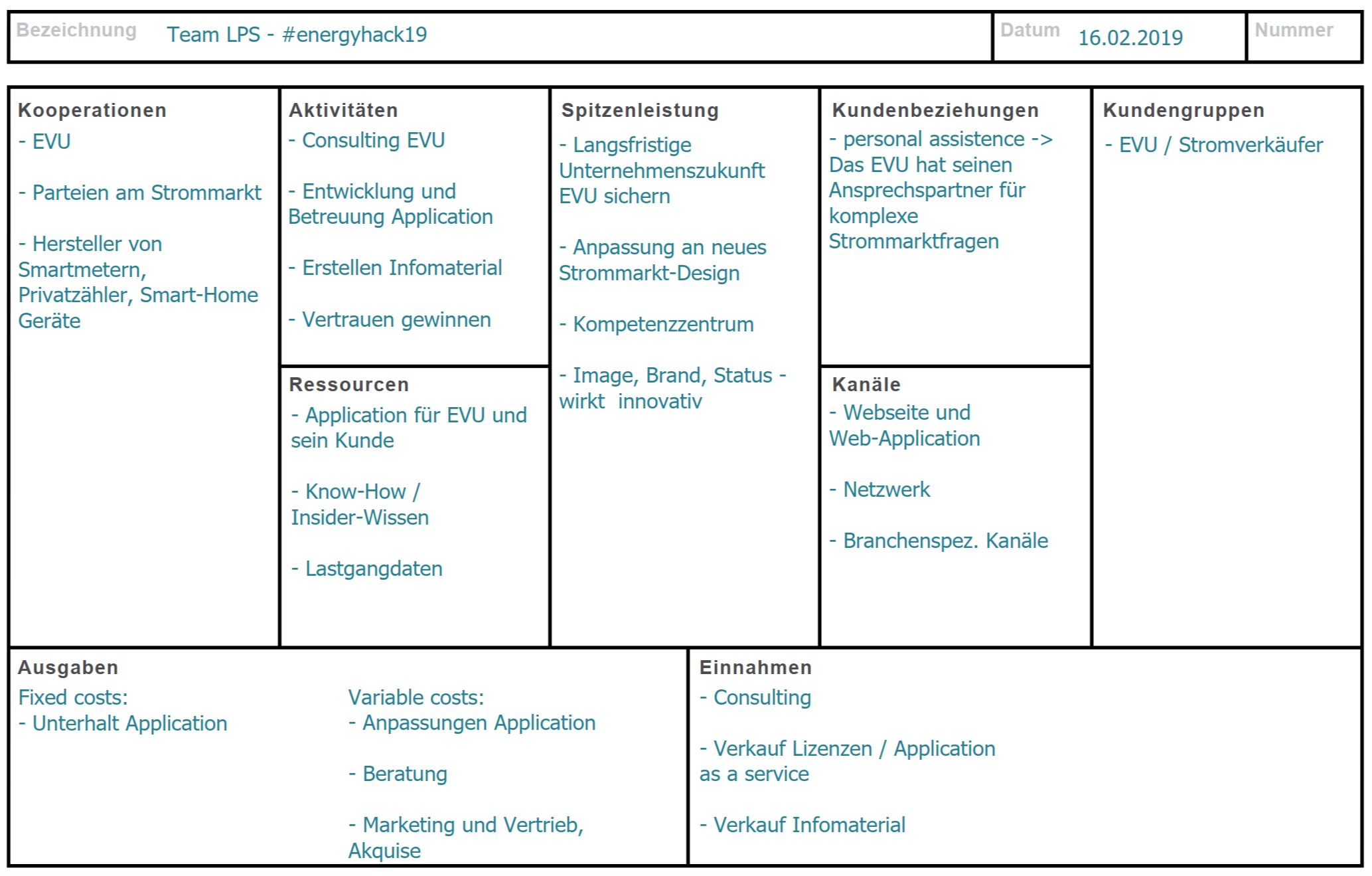
PV Diagnose
An application for small scale PV owners to check whether their installation is still healthy.
We created a web app that allows users to check the status of their solar installations by evaluating if the energy production is at a normal state. Our application aims at providing a quick verification of the monthly energy production of rooftop solar panels. The user will provide the following input:
- Location of the solar panel: address
- Size of PV: area in m2
- Capacity kWp
- 12 months of production data
The app looks up the estimations from sonnendach, compares the the input and returns:
- Location on map
- Status: ok or not ok
- Monthly comparison of actual vs. reference as a bar chart
See our wiki for more information.
Here the web app prototype (1) user interface and (2) output results - bar chart and diagnosis
Team members: Tetiana, Adrian, Andreas, Angelos, Bogdan, Braulio, Daniel, David, Martin (@Mhertach) and Tobias
SBB ZEV
Visualize the potential of different SBB buildings as self-powering communities
SBB ZEV aims to analyse the potential of different SBB buildings to become self-powering entities. In a second step, this evaluation will be visualised to make it more accessible.
Data & code: Notebook
Challenge: Max PV-Strom SBB-Arealen
PV-Potential on SBB-Areas
The goal of the project is to assess the PV-potential of areas owned by SBB. We use a dataset from SBB containing: Jahresverbrauch, Anschlüsse, and Gebäude-shapes, for each address. On this dataset we did a general potential analysis over all addresses. For a more detailed assessment and visualization of potential "Zussammenschlüsse" of adjoining parcels we linked the SBB data with the swiss energy planning app of geoimpact which collects, links, and visualizes several open datasets (e.g., from Sonnendach, Elcom, ...)
General Potential Analysis
PV-potential over all SBB-areas:
**** 153 GWh (LCOE<10 Rp/kWh) --> 0.3% of total swiss electricity consumtion ****
**** 270 GWh (LCOE<15 Rp/kWh) --> 0.5% of total swiss electricity consumtion ****
CO2 reduction potential over all SBB-areas:
**** ~7000 tons of CO2 reduction (LCOE<10 Rp/kWh) ****
**** ~12000 tons of CO2 reduction (LCOE<15 Rp/kWh) ****
Figure: Total electricity generation potential from PV: 130 GWh (LCOE<10 Rp/kWh), 270 GWh (LCOE<15 Rp/kWh). Ranking of Gemeinde by total potential area for PV installation (roof area that intersects and within the parcel):
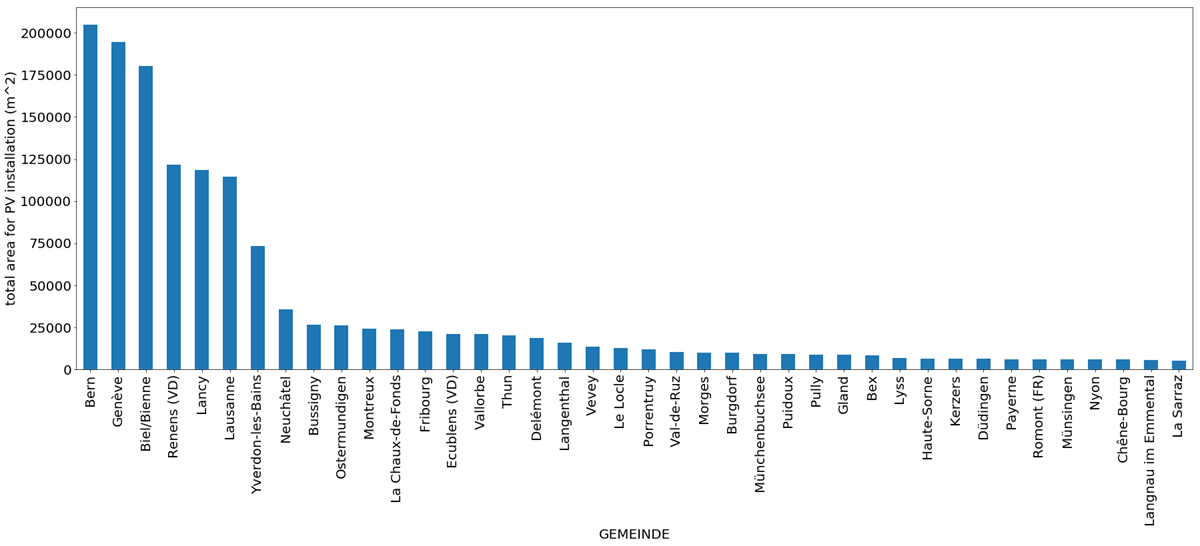
Figure: Potential vs. PV LCOE for each parcel. With Gemeinde names where the parcel is located in. Parcels on on top left corner (high potential, low LCOE) shall be looked into:

Data and code: https://github.com/magnetilo/max-pv-strom-sbb/blob/master/SBB ZEV - levelized cost of electricity.ipynb
Assessment and Visualization of parcels and potential "Zusammenschlüsse zum Eigenverbrauch (ZEV)"
When you want to find ZEV you need to consider the geographic locations of the SBB-parcels, most importantly if two parcels are linked to each other through parcels that belong all to the same owner. In the case of SBB the ownership of train-track-parcels is especially interesting as they link different parcels over a large range (virtually over the whole country), which allows potentially for huge ZEV (see figure "SBB Areale & Möglichkeiten ZEV"). However, it is not clear yet if the connection across train tracks is physically feasible and makes economically sense.
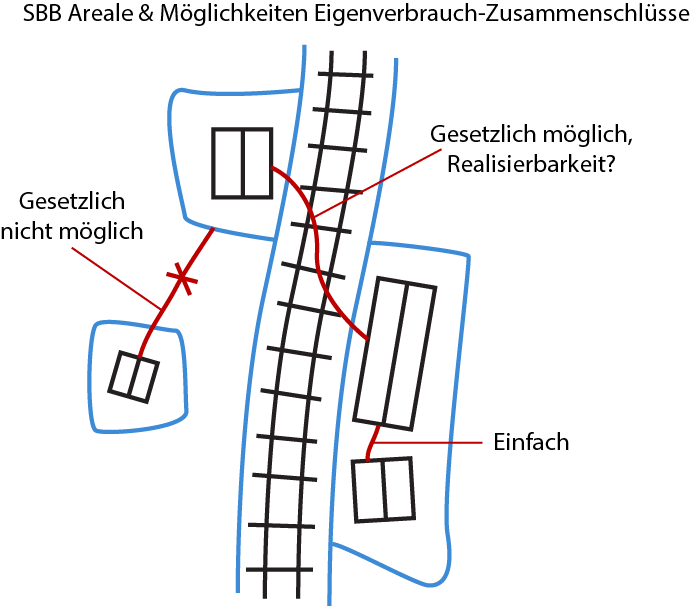
We approach the assessment of the potential for ZEV with a qualitative model considering the aspects: "Energie", "Wirtschaftlichkeit", and "Realisierbarkeit". We divided our team into three subgroups working on the topics data, model, and visualization (see figure "Teamaufteilung").

The main task of the data team was the embedding of the SBB data into the swiss energy planning app, where several nasty problems arose.
The model team developed a qualitative model based on quantitative data for assessing the potential of each SBB parcel (or potentially any cluster of parcels, see figure "Modell").
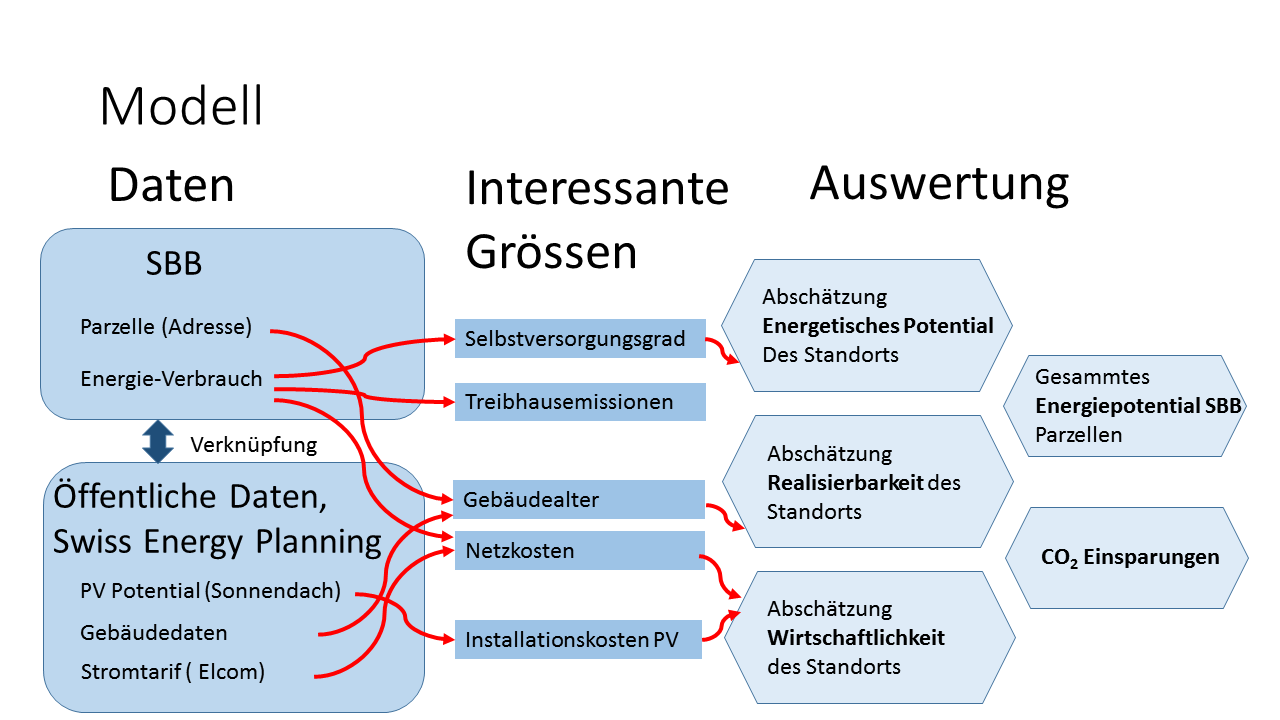
Finally, we visualized the potential assessment and all the information of interest for each parcel on a interactive map in the swiss energy planning app (see figure "Swiss Energy Planning").

Videmus
Strengthening citizen participation in damage reports
Videmus is a tool to develop a citizen participation for energy-related damage reports. It aims to allow citizens to easily report if they perceive a damage or potential point of improvement in their "energetic" surrounding.
Friday update: In the start phase we found that similar tools exist already and that it wouldn't make sense to program this tool again. Instead, we looked at business model and potential pain points in order to plan the implementation of such a tool. The idea now is to pool public utilities and find a business case for a potential startup.
Challenge: Bürger-partizipation

Videmus
Es geht darum, ein Tool zu entwicklen für die Bürgenpartizipation beim Melden von Zuständen (Schäden) an der Versorgungs-Infrastruktur.
Recherchen haben ergeben, dass es solche Tools bereits gibt, so z.B. von der Stadt Zürich (zueriwieneu.ch), als Teil der SBB Mobile App, von den IBB (ibbrugg.ch) und weitere. Diese erfüllen ihren Zweck offenbar gut, haben aber gewisse defizite. Zum einen sind sie nicht einfach zu bedienen, zum anderen werden die Daten nur isoliert betrachtet und nicht öffentlich verfügbar gemacht.
Ziel unseres Ansatzes ist es, solche Daten im Sinne von Open Data öffentlich verfügbar zu machen. Das Team hat ein Kollaborationsmodell entwickelt, das den Wert der Veröffentlichung solcher Daten aufzeigt. Die Besitzer/Betreiber der Infrastruktur haben grosses Interesse an solchen Meldungen, da es ihnen erlaubt, fehlbare Zustände schneller und mit weniger Personalaufwand zu erkennen. Zudem ist es für sie interessant, solche Daten öffentlich zugänglich zu machen, denn ein Betreiber allein hat nur wenige Daten und mit Zugriff auf die Daten aller Betreiber lassen sich aussagekräftigere Datenanalysen erstellen.
Wir haben geprüft, ob die Bürger für solche Meldungen eine Belohnung erhalten sollten. Solche Belohnungen können z.B. in Form von Migros Cumulus Punkten erfolgen; bezahlt von den Infrastrukturbetreibern. Umfragen haben ergeben, dass es vermutlich besser ist, mit der intrinsischen Motivation der Bürger zu arbeiten. Man will ja auch nicht, dass die Bürger Objekte beschädigen, um dann eine Belohnung für eine Meldung zu bekommen.
Zudem haben wir mit einfachen Mitteln ein Online-Formular erstellt, mit welchem solche Meldungen gesammelt werden können. Die gesammelten Daten veröffentlichen wir als CSV.
Siehe auch die Schlusspräsentation: https://github.com/kreba/videmus/blob/master/videmus_4.pptx?raw=true
Data
Online Formular: https://form.jotformeu.com/90455619251357
Gesammelte Daten: https://docs.google.com/spreadsheets/d/e/2PACX-1vQAlHdhghXRPd7bSL8xOZZ2jyKiDd52i6nc4sGKIBZPOAjEgzGrnp94-cFBAqF-LDNQyfHjjBrAJYq1/pub?output=csv
Landkarte: https://kreba.github.io/videmus/
Visistrom
Using electricity at the right time help to avoid unsustainable sources
VisiStrom
Visistrom helps individuals to plan using electricity at a good time in order to use sustainable energy as much as possible. In turn, this behaviour helps utility companies to reduce energy purchases from expensive sources like coal and oil plants.
Energy Hack Days
This project emerged from the following Open Energy Hack Days challenge: Visistrom challenge.
16.02.2019, 08:00 - Second Update: A basic version of the prototype is running.
15.02.2019, 18:00 - First Update: We realized that it is not just about consuming as little as you can - it is also important that when you consume the electricity, you want to avoid coal-produced electricity. Some solar energy is being produced, sometimes it is good to use electricity when the sun is shining. We are trying to come up with a good visualization to tell this message. There are three recommendations for the end user: now is a good time to use electricity, now you should save, or just keep going. We are quite advanced with visualization, we have some nice data we can use, but the challenge is how to decide when to recommend using electricity.
Design Challenge
How might we visualize peaks, valleys and provenance of electric power, so that end consumers know when consumption and production is most ecological and/or cheapest?
Business Goals
Minimize the necessity to buy expensive, "dirty" electricity (produced from oil and coal).
- reduce peaks (peak shaving)
- reduce unplanned differences in consumption and production
Data Analytics
To make a recommendation of when to use electricity or not, we need to try to avoid peaks in consumption, at the individual household level, and at the area level.
1. Consumption for a given household
Predict consumption peaks and valleys for a given time based on the household's past consumption:
- for a given hour during the day (e.g. from 3pm to 4pm)
- on a given day of the week (e.g. Saturday)
- in a given month of the year (e.g. July) --> not using that at the moment yet
At the moment, the front-end app prototype uses the non-processed usage data from last year as a proxy prediction.
Data source:
Aggregated load profiles of apartment blocks
- Aug 2017 - 31. Aug 2018
These are Smartmeter measurments in 15-minute intervalls by blocks of flats (usually about 3-8). It's not by individual households, but this is a good enough apporximation for now.
2. Consumption for Kanton of Aargau, SwissGrid
As a proxy for prediction data from the utility provider Energieübersicht 2018, Swissgrid (Kanton Aargau) Scaled down to match 01.01.2018-31.12.2018
3. Consumption for a given area (TO DO)
Predict consumption peaks and valleys for a given time based on the area's past consumption:
- for a given hour during the day (e.g. from 3pm to 4pm)
- on a given day of the week (e.g. Saturday)
- in a given month of the year (e.g. July)
Data source:
- Aggregated load profiles of apartment blocks (summed up)
- Or alternatively: load profiles from Trafo stations (not openly available)
4. Solar panel production for a given household
Predict production peaks and valleys for a given time based on sunlight and on the household' past solar panel production:
- for a given hour during the day (e.g. from 3pm to 4pm)
- on a given day of the week (e.g. Saturday)
- in a given month of the year (e.g. July)
Data sources: Solarenergie Prognose from NETSTRANSPERNENZ
Optional data to refine the prediction at household level: Past production of solar electricity for this household
Functionality
The functionality purpose for the consumers is:
- to adapt their behaviors to have cleaner energy usage
- to see their progression in energy consumption over time
To adapt their behaviors, accessible data of factors impacting energy production will be shown to the user. Such include prevision of solar intensity for the upcoming week, coupled with other data such as past average consumption habits of the Club. Data can also integrate predictable special events susceptible to induce consequent perturbation in the general consumption (e.g. World Cup Football).
The integrated data is presented to the user in the form of a table showing predicted energy conditions for the upcoming week, for every hour. The table will highlight the day and hours when clean energy will be the more available among the week. This will enable users to plan their energy most consuming tasks (usually cooking and housekeeping) according to external energy availabiity conditions.

The user will be able to click on the case of the table to access to more details explaining the reasons why he/she should stay to his current task planification or move it to anothe time:
- sunlight availability
- saturation of Club
- etc.
To see their progression over time, consumers will have access to the profile curve of their past days, weeks and months consumptions. They will also be able to see the difference between their actual daily consumption of a specific weekday with average of past consumption for the same weekday.

Home Screen
The Home Screen is split in half. In the upper part, an icon is shown as a quick and easy-to-understand indicator for the user - a call to action. The icon shows one of three states:
- the lightbulb is turned on, which means that the club produces more energy than expected and the user is welcomed to increase his or her energy consumption (invest more energy)
- the lightbulb is turned of, which means that the club consumes more energy than expected and the user is welcomed to decrease his or her energy consumption (save some energy for later)
- the lightbulb is cut in half showing a balance of a turned on and turned off light, which means that the club is on track and the user does not need to change anything.
A click on the icon will show the user a forecast of the lightbulb so he or she can plan their energy consumption ahead.
Forecast Screen
As an end consumer, I want to know when is the best time to use electricity in the coming hours and days, so that I can plan energy-intensive tasks accordingly (e.g. doing the laundry, charging my electric car,...)
Implementation: The Lightbulb Forecast Screen shows a series of lightbulbs from top to bottom. Each lightbulb belongs to a specific time period (e.g. 1 hour, 1 pm - 2pm). Similar to the lightbulb on the Home Screen, the lightbulbs indicate whether the specific period is more likely to be a period to spend or save energy.

Backlog (not implemented yet)
Notification / Reminder:
User Story: As an end consumer, I want to get notified of the best time to use electricity, so I don't have to check the app actively.
Implementation: On the "Forecast" screen, a click on one of the lightbulbs (= time period) gives the user the option to set a reminder (e.g. to vacuum clean).
Drill-Down
As an end consumer, I want to see the forecasted consumption and production for a particular time period (e.g. today 3-4pm), so that I understand why I get a recommendation to use or save electricity at that time.
My Realm Screen (not yet implemented, coming soon)
The My Realm Screen shows the energy consumption of the user's home or flat using a simple graph. The data is limited to the last 24 hours. If possible, different energy consumers will be shown separately as well as aggregated. As an example, the bas load (typical household appliances), the usage of the battery, the pv production as well as the consumption of the heatpump could be shown. The user can switch between the aggregated view, showing only "what flows into / out of the house" or the detailed view.
My Club Screen (not yet implemented, coming soon)
Club is the term for a group of customers connected to the same network node Similar to the My Realm Screen, the My Club Screen shows a simplified overview of the electricity network area the user is connected to (automatically determined, login required). On the one hand, the graph shows the performance of the network within the last 24 hours. On the other hand, the graph shows the number of participants or rather their aggregated energy consumption and production in order to highlight the ratio and improve that.
My History Screen (not yet implemented, coming soon)
The My History Screen provides a filter mechanism to specify a period of interest. As an example, the user can select from last day, last week, specific week, last month, specific month, last season, specific season, last year and custom from/to dates. The specified period is then being displayed as a graph whereas the scaling is determined by the period itself. Additionally, the user can add a second period of the same kind in order to start comparing time series. As an example, the user could compare the last week with the same week a year ago.
Compare Appliances Screen (not yet implemented, coming soon)
The Compare Appliances Screen is meant to support the user in acquisition decisions. It focuses on the operational costs based on electricity consumption of the specified appliances. In the first version, the user can input 5 values into the form:
- electricity consumption when turned on in Watt
- hours of operation per year in hours
- electricity consumption when in stand by in Watt
- hours in stand by per year in hours
- electricity cost (default value provided by operator)
After putting the values in, the estimated electricity costs of that appliance is being shown. The user can add multiple appliances in order to compare them.
Additionally, a list of typical values is being shown, as for example the number of hours a tv is being operated in general (as a rule of thumb).
What can I do Screen (not yet implemented, coming soon)
In the first versions of the What can I do Screen, a list of typical electrical appliances will be shown. The list should help the user to decide which devices can be turned on or turned off, depending on the current situation. In later versions, these options can be improved by
- showing only appliances the user actually has
- highlighting appliances that can actually be turned on or turned off (e.g. not showing a boiler that is already beeing running)
- sorting the list in a smart way (taking the power consumption, ramp up time, saving potential, etc. into account)
Supportive Messages (not yet implemented, coming soon)
The system motivates the user by displaying a supportive message every now and then. A message can be displayed when the user simply opens the app/website (e.g. 'It's nice to see you here', 'Welcome back!'). More importantly, a message should be shown if the user has seen a call to action (e.g. lightbulb is turned on) and the system notices that the energy consumption of the user actually dropped (e.g. 'Thank you for your support, you helped the Club!').
What is Watt
What is Watt helps individuals to understand the energy need of different devices and activities.
Gut gemeinte Ratschläge sind weit verbreitet, wenn es darum geht Energie zu sparen. Aussagen wie «Lösch das Licht, wenn du den Raum verlässt» oder «Du musst ja für ein Stockwerk nicht den Lift nehmen» sind gut gemeint. Die Ratschläge umzusetzen, ist jedoch immer mit einer Verhaltensänderung verbunden. Die Erfahrung, wie schwierig es ist gute Vorsätze umzusetzen zeigt: jede Verhaltensänderung ist teuer.
Demo: https://jonasoesch.ch/content/work/what-is-watt/v2/
Challenge: What is Watt setzt einen Schritt vor dem Ratschlag an. Das Projekt hilft bei der Entscheidung, welche Verhaltensänderungen sich wirklich lohnen. Damit auch die eigene Energie effizient eingesetzt wird.
First Update
Right now we came up with the idea of having a map of all kinds of different things you can do with energy in your daily life. We want to let people explore this map of stuff, and to see how everything is related to everything. It is an ambitious goal which we will never reach this weekend. Still we think we will reach it, and will do our best. The data is available for most things, it's going pretty well. I hope we see some results in the next few hours.
Second update
We have overhauled the interface and created a next iteration of the webapp:
https://jonasoesch.ch/content/work/what-is-watt/v2/

Data
- Daten (Google Spreadsheet)
Source
What is watt?
The goal of this project is to make the energy usage of different activities comparable. It is composed of two parts:
- Collecting data and creating parametrizable models
- Providing a gamified interface

A first Demo of the interface.
Hackathon
What is watt was evolved during the Energy Data Hackdays 2019 in the Hightech Zentrum in Brugg. Many thanks to: Anna, Germaine, Katharina, Madlaina, Sinan and Stephen.
Some collected results:
- First Django prototype on Github
- First Django prototype on Heroku
- Collected Data Google Drive
- Frontend Github
Pitch
Ziel von What is Watt ist es, alles mit allem zu vergleichen. Wie viel Energie verbraucht meine tägliche Pendler-Zugfahrt? (12.8 kWh) Und wie oft kann ich mit dieser Energie heiss duschen? (9 Mal) Oder einen Stock mit dem Lift fahren? (1200 Mal) Es bleibt am Ende die Entscheidung der einzelnen Person, ob sie nun näher zu ihrem Arbeitsort zieht oder weniger lang/heiss duscht, um Energie zu sparen.
Natürlich hängen die obigen Werte von der Pendlerstrecke, der Duschdauer und der Liftart ab. Und auch was verglichen werden soll, ist oft sehr individuell. What is Watt ist deshalb auf allen Ebenen als offene Plattform konzipiert:
- Offene Daten dienen als Grundlage zur Berechnung der Szenarien.
- Die Berechnungsmodelle sind offen und dokumentiert. Man kann sie somit nachvollziehen, kritisieren und verbessern.
- Das Resultat jedes Szenarios ist ein Wert in Kilowattstunden. Neue Szenarien lassen sich so leicht hinzufügen und mit allen bestehenden vergleichen.
- What is Watt stellt die Szenarien über eine offene API zur Verfügung. Damit können unterschiedliche Interfaces und Visualisierungen die Daten auf ganz verschiedenste Art zugänglich machen.
Da alle vier Ebenen offen sind, ist es jedem möglich zu What is Watt beizutragen. Typischerweise ist es ein neues Szenario, das jemanden persönlich interessiert. Wie viel Energie zum Beispiel eine Bitcoin-Transaktion verbraucht. Oder die eine Modelleisenbahn. Oder die E-Gitarre.
Die Teilnehmer der Energy Data Hackdays können sich auf jeder der vier Ebenen betätigen und einen Beitrag zur Plattform liefern.

Und wer sich nun fragt, wie viel Energie eine Bitcoin-Transaktion verbraucht, hier die Antwort:

A single bitcoin transaction uses the same amount of electricity as 176 hot showers. So enjoy one more month of showering this year instead of shopping in bitcoin ;-) pic.twitter.com/iVKOGbEems
— Jonas Oesch (@jonasoesch) May 21, 2018
Running with Docker
You need to have Docker installed and running.
docker build -t whatiswatt .
Creates a new docker image with all the necessary requirements
To run the application:
On macOS
docker run -p 8888:8888 -v ~/Desktop/What-is-What:/app whatiswatt
On Windows
docker run -p 8888:8888 -v /c/Users/jonas/energyconverter:/app whatiswatt
sbbweather
What influence does the weather have on your train journey?
This team is analysing fresh SBB weather data.
Challenge
Data
Statt teuer Wetter Daten einzukaufen, könnten die Daten vom Integrated Surface Database (ISD) des amerikanischen Wetterdienst bezogen werden. Enthalten sind hier die historischen Stundenwerte aller Wetterstationen weltweit. Die Daten sind frei verfügbar.
First Update
We are working with SBB weather data, did some wrangling and found some outliners which they were very thankful for - e.g. some trains which ran 1 km per second. The data is 2GB of 5 minute periods for one year, it's in a separate file to the track data. Still struggling with that, but we have some models we are planning, and ran some already on the data. We'll see what we can build by tomorrow.
Energielast Tool
Für einen produktiven Einsatz bei den SBB könnten die Real-Time Daten von MeteoSchweiz (Open Data) eingebunden werden. Es könnte dann der Energieverbrauch berechnet werden. Ein sehr einfachen Prototype findet sich unter http://hackday.nemundo.ch


